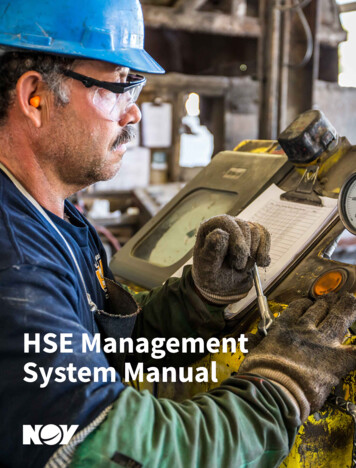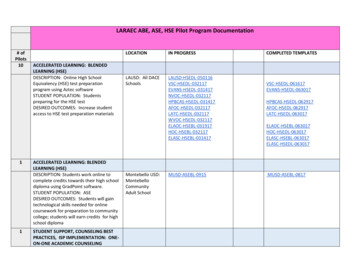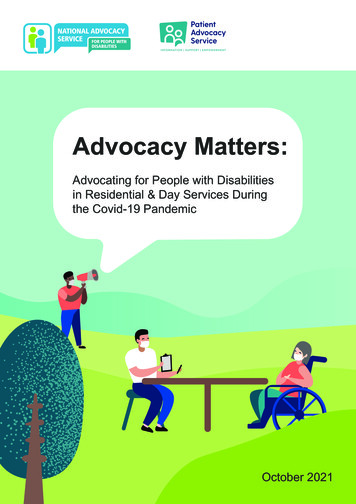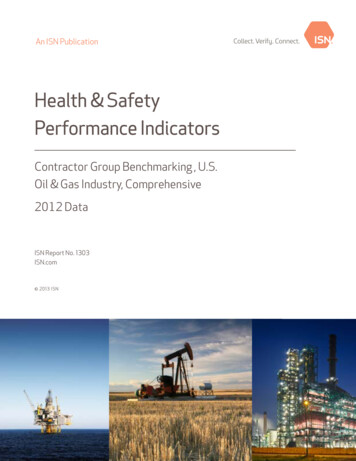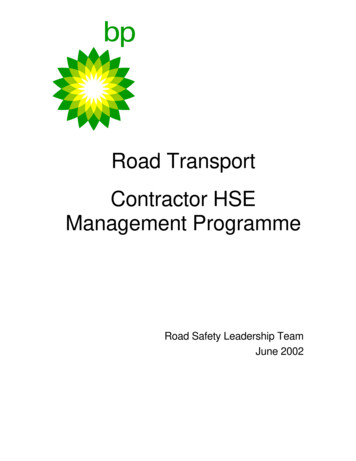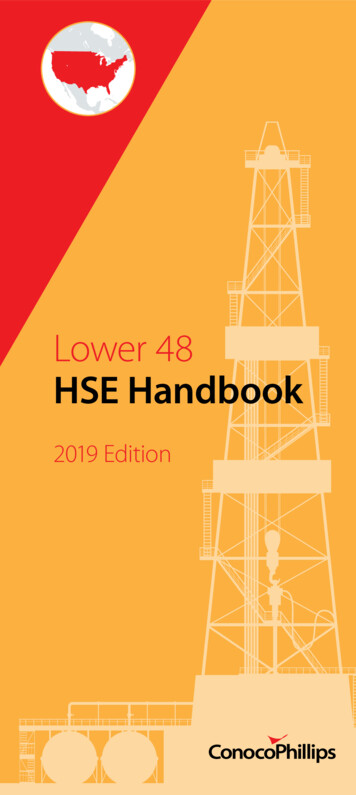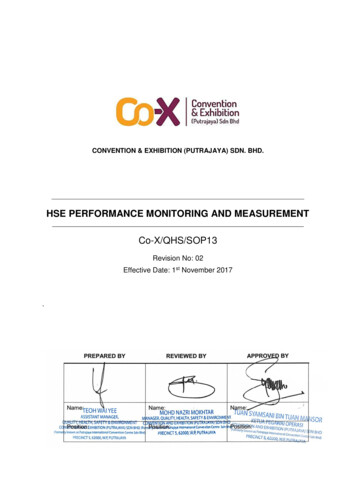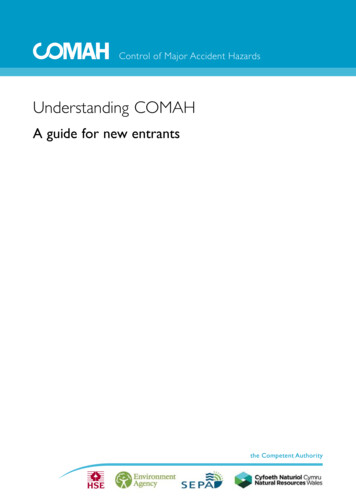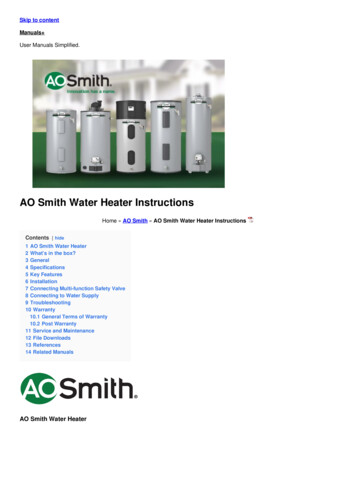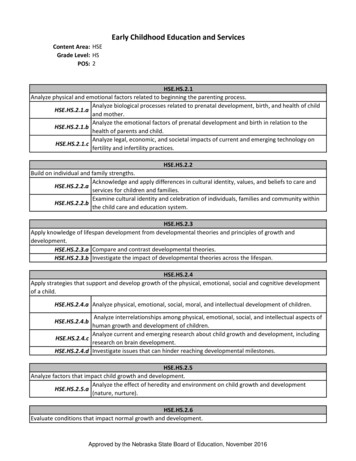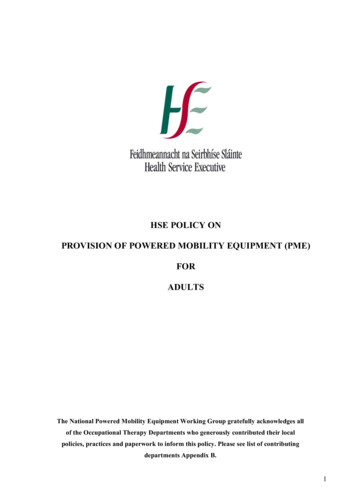
Transcription
HSE POLICY ONPROVISION OF POWERED MOBILITY EQUIPMENT (PME)FORADULTSThe National Powered Mobility Equipment Working Group gratefully acknowledges allof the Occupational Therapy Departments who generously contributed their localpolicies, practices and paperwork to inform this policy. Please see list of contributingdepartments Appendix B.1
PageIndexHeading41.0Policy Statement42.0Policy Purpose53.0Scope54.0Definitions and Abbreviations54.1Service User54.2Carer54.3Powered Wheelchair54.4Mobility Scooter55.0Responsibilities55.1Prescribing Clinician65.2Line Manager65.3Prescribing Clinicians in agencies other than the HSE66.0Policy66.1Provision of PME to adult service users76.2Criteria for provision of PME to adult service users76.3Assessment for provision of PME to adult service users96.4Specialised Seating96.5Consultation97.0Training and Education98.0Third Party Insurance109.0Restriction of Use1010.0Transport of PME1011.0Change in service user’s condition1012.0Ordering and Maintenance of PME1012.1Ordering of the PME1112.2Adjustment of the PME1112.3Repair of the PME1112.4Service and Maintenance of the PME1112.5Recycling of the PME1113PME Completion Checklist1114HSE/PME Provider Review of Use of PME by the2
1215Frequency of Audit and Review of this Policy13Appendix ANational Working Group Members13Appendix BContributing Occupational Therapy Departments14Appendix CProcedure for Assessment and Training of PoweredMobility Users16Appendix DPowered Mobility Assessment Record19Appendix ELetter to Service User/Carer20Appendix FLetter to GP21Appendix GRequest for medical information Form22Appendix HRefusal letter to Service User23Appendix IPowered Mobility Equipment Training Agreement24Appendix JPowered Mobility Skills Test31Appendix KPowered Mobility Skills Practice Sheet32Appendix LTerms and Conditions for provision on loan of HSEpowered mobility equipment36Appendix M37BibliographyPowered Mobility Equipment Check list3
Feidhmeannacht na SeirbhíseSlàinteHealth Service ExecutivePage: 1No of Pages: 37Date: 20.10.13Policy Title: Provision of Powered Mobility Equipment (PME) for AdultsWritten by:National Policy Working Group on Provision of PoweredTitle:Appendix A.Mobility Equipment for Adults and ChildrenApproved by: HSE National Disability Governance Group1.0 Policy StatementThe HSE aims to provide a community health care service that is high quality, safe, valuefor money and evidence based (HSE 2008). The development of protocols and policies thatreflect and support best clinical practice is essential in the provision of care and support toservice users and their families. The HSE Occupational Therapy staff is committed toproviding an equitable, accountable and transparent process when assessing and issuingpowered mobility equipment (PME) for all service users. This will be in partnership withother relevant professionals as indicated by the individual service user’s needs. For thepurpose of this policy, PME is defined as a powered wheelchair or a scooter.2.0PurposeThis policy provides a standardised approach on the assessment, criteria for provision andprovision/review of HSE funded PME to service users in a community setting. It is toensure that service users/carers receive a comprehensive assessment of need and receiveadequate training in the use of the PME.4
3.0ScopeThe scope of this policy applies to all professional staff working within the HSE and HSEfunded organisations who are engaged in assessment and provision of HSE funded PME.This policy should be read in conjunction with relevant standards of Irish professionalbodies of those involved in assessment, applications and provision of HSE funded PME.4.0Definitions and Abbreviations4.1Service UserFor the purposes of this policy, service user means a person to whom a prescribingclinician renders a professional service4.2CarerFor the purpose of this policy, the carer shall be defined as the person who looks after orsupports the service user with their day-to-day activities4.3Powered WheelchairThis is a wheelchair (with or without special seating support) which has a battery poweredmotor and is controlled by a choice of hand, foot or head controls, depending on theabilities of the user. It can be controlled by the occupant, carer or both. (Novita 2012)4.4Mobility ScooterA mobility scooter is usually battery powered and has a seat over three or four wheels, aflat area or two footplates for the feet and handlebars in front to turn one, two or threesteerable wheels. This is a PME aid for outdoor use, generally considered for a service userwho does not have complex seating needs.5.0Responsibility5.1Prescribing ClinicianIt is the responsibility of the prescribing clinician to ensure they carry out a comprehensive,thorough assessment as per 6.3 below in collaboration with other professionals relevant toeach service user’s needs prior to prescribing PME. They must also complete training withthe service user/carer in the safe use of this equipment (see Appendix C)5
5.2Line ManagerIt is the responsibility of line managers to ensure that all staff within their responsibility areaware of and implement this policy.5.3Prescribing clinicians in agencies other than the HSE5.3.1 Where the assessment has been carried out by staff from agencies other than the HSE,it is their responsibility to liaise with HSE Occupational Therapy staff re the suitability ofthe PME. The HSE Occupational Therapy service has the ultimate responsibility forrecommending approval for funding of PME equipment.5.3.2 Clinicians from agencies other than the HSE who are prescribing PME must adhere toHSE Terms and Conditions (Appendix L) for HSE funded PME5.3.3 The State Claims Agency does not provide an indemnity to non HSE clinicians,irrespective of whether the HSE fully or part funds the organisation which employs thoseclinicians. It is the responsibility of each agency therefore to ensure their employees holdadequate Professional Indemnity Insurance cover.5.3.4 Where the service user has been assessed for and trained in use of a PME by aclinician from an agency other than the HSE, the service user/carer must agree to therecommendations for use made by that professional.6.0Policy6.1Provision of PME to adult service usersPME should only be considered where the service user’s mobility needs cannot be met bymore cost effective solutions such as a manual wheelchair. A service user/carer does nothave an entitlement to be provided with an HSE funded PME where they have beendeemed suitable following the assessment process and eligible per criteria in section 6.2.The HSE has budgetary restrictions within which it must operate and on which theallocation of PMEs is dependant. For some service users assessed as suitable and eligiblefor a PME per section 6.2, this may result in a waiting period.6
6.2Criteria for Provision of PME to Adult Service UsersEach service user will be provided with an assessment of need for a PME but a HSE fundedPME can only be provided when all of the following criteria are met: The service user has a valid medical card, LTI card or HAA card The service user has impaired mobility/medical disability which significantlyaffects their independence and quality of life, e.g. deficit of the locomotor system orchronic heart or lung condition, which has caused a severe and permanentrestriction in walking The service user must be unable to propel a manual wheelchair sufficiently to carryout activities of daily living (by reason of muscle weakness, increased tone,stiffness, in-coordination, deformity, pain or severe fatigue or breathlessness). Theservice user may be an occasional user of the manual wheelchair for ease of accessto transport and/or as a back up wheelchair A full assessment of the service user’s ability and needs has been undertakendetailed in 6.3 below and PME has been recommended by the prescribing clinicianto promote function and independence. The provision of the PME will enable theservice user to maintain their mobility by enabling easier access to the home andwork and/or where the external environment is unsuitable for manual wheelchairuse Procedure for Assessment and Training of Powered Mobility Users (AppendixC) has been completed in full when a PME referral is submitted for funding. An attendant controlled powered wheelchair may be provided where thefamily/carer experiences difficulty in pushing the service user in a manualwheelchair and where the service user cannot safely drive a powered chairin/outdoors. The service user/carer understands that the PME is for the sole user of the serviceuser and agrees not to permit the PME to be used by another person. The service user/carer acknowledges that the PME cannot be altered or modified inany way whatsoever.6.3Assessment for provision of PME for Adult Service Users A full Powered Mobility Assessment Record will be completed and documentedon the Powered Mobility Equipment Assessment Record (Appendix D). Thiswill include:7
o Home environment to ensure adequate space for movement/storage of the PMEoPhysical Assessment in collaboration with other relevant professionals toascertain the adult’s seating and pressure management needso Perceptual Assessment, Behavioural and/or Cognitive Screen where indicatedThe Letter to Service User/Carer (Appendix E) will be sent to the serviceuser/carer, along with the Letter to GP (Appendix F) and Request for MedicalInformation Form (Appendix G) to be completed by the GP and returned to theassessor. On re-referral, review assessments will only require completion of this step whenthe assessor has concerns about significant changes in the service user’s medicalcondition A Refusal Letter to Service User/Carer and their GP/referrer including thereasons for refusal will be sent if the service user is unsuitable for PME (seeAppendix H). In this case, a copy of the HSE’s “Your Service, Your Say” will alsobe included with the Refusal Letter. This is in order to facilitate service users/carerswho might wish to challenge such a refusal decision through the HSE internalcomplaint system. The Powered Mobility Equipment Training Agreement (Appendix I), a signedcontract between the service user and the prescribing clinician must be completedprior to starting PME training and a copy provided for the service user/carer. In addition, the ‘Terms and Conditions for the Supply on Loan of the PoweredMobility Equipment (appendix L)’, also a signed contract between the serviceuser/carer and prescribing clinician, must be completed prior to starting PMEtraining and a copy provided for the service user/carer The prescribing clinician submitting the completed assessment and application forHSE funded PME must include the ‘Terms and Conditions for the Supply onLoan of the Powered Mobility Equipment’ signed and dated by the serviceuser/carer as relevant. Competence in the use of the PME using the Powered Mobility Skills Test(Appendix J) must be demonstrated by the service user (in a service user controlledpowered wheelchair) or by the carer (in an attendant controlled poweredwheelchair) and documented8
The prescribing clinician submitting the completed assessment and application forHSE funded PME must include the ‘Terms and Conditions for the Supply onLoan of the PME (Appendix L) signed and dated by the service user/carer asrelevant6.4 Specialised SeatingThis policy focuses on the service user’s need and suitability for PME.While theclinician’s assessment will include the evaluation of the service user’s postural/positioningneeds, the need for this specialised seating does not determine the service user’s suitabilityfor PME.6.5 ConsultationConsultation with other professionals involved with the service user may also be carriedout according to the individual young person’s needs7.0 Training and Education The prescribing clinician is responsible for providing comprehensive training in theuse of the PME to the service user (for self controlled) or the carer (for attendantcontrolled PME) to ensure competent use of the equipment. Each training sessionshould be recorded using the Powered Mobility Skills Test (Appendix J) A Powered Mobility Skills Practice Sheet (Appendix K) should be provided tothe service user /carer with skills to be practiced between sessions. The prescribing clinician must ensure that the service user/carer is competent insafe use of the equipment, including all aspects of manual handling, seating andsafety on the road. It is the responsibility of the relevant line manager to ensure that all relevant staffare trained and/or receive training in the assessment for and the use of PME The “Powered Mobility Equipment Completion Checklist” (appendix M) mustbe fully completed by the end of the training and education and kept in the serviceuser’s file8.0 Third Party InsuranceThe prescribing clinician must advise the service user/carer that they should considerinvesting in appropriate insurance to cover the service user/carer’s liabilities arising fromtheir use of the PME. The service user /carer must accept that they will be responsible for9
loss and injury to persons or property caused by the negligent use of the PME whilst it isunder their control. They must agree to indemnify the HSE/PME provider arising fromtheir breach of the Terms and Conditions of Use and sign the Terms and Conditions form(Appendix L) to that effect.9.0Restrictions of UseFollowing assessment, and during and/or on completion of training, the prescribingclinician may provide the service user/carer with restrictions of use of their PME for theirsafety and the safety of others.The State Claims Agency has recommended that PMEs should not be used on the roadexcept in exceptional circumstances where necessary and that prescribing clinicians shouldadvise PME users accordingly.10.0 Transport of PMEWhere a service user is being transported in their PME in a vehicle, the prescribingclinician should advise the service user/carer to follow equipment suppliers transport safetyrecommendations as outlined in the Service User manual for the specific PME.11.0 Change in Service User’s ConditionNot withstanding the entitlement of the HSE to review, it is the service user/carer’sresponsibility to contact the prescribing clinician if there is a change in the service user’scondition which impacts on their ability to use the PME.12.0 Ordering and Maintenance of the PME12.1 Ordering of the PMEAll PME .must be recommended for funding approval by the HSE Occupational TherapyManager and/or Senior Occupational Therapist prior to ordering and ordered in accordancewith local purchasing approval requirements. The HSE National Financial Regulations 1Purchase to Pay (2012) apply to all equipment purchases within the HSE.10
12.2 Adjustment of the PMEAny necessary modifications or alterations are to be carried out strictly and solely by thePME provider in agreement with the manufacturer’s recommendations. Any alteration ormodification to the PME by the service user/carer constitutes a breach of the Terms andConditions of Use and the provision of Section 14.0 shall apply.12.3 Repair of the PMEIt is the service user/carer’s responsibility to contact the OT Department/ApplianceDepartment if there is a breakdown of equipment. The HSE provides for repair as a resultof normal wear and tear. The service user/carer is liable for repairs and maintenance arisingfrom misuse of the PME.12.4 Service and Maintenance of the PMEIt is the responsibility of the HSE to arrange a service of HSE funded PME. It is theresponsibility of the prescribing clinician to contact the local HSE OT Department for localprocedures. Manufacturer’s guidelines should be adhered to in all cases.12.5 Recycling of the PMEIt is the service user/carer’s responsibility to contact the HSE OT Department when thePME is no longer required to arrange for it to be returned to their local HSE OTDepartment. On return, the Occupational Therapy Department will arrange fordecontamination, a maintenance check and recycling if deemed appropriate13.0 PME Completion ChecklistThe PME Completion Check List (Appendix M) must be fully completed by the end ofthe training and education and kept in the service user’s file in the prescribing clinician’sorganisation along with all documentation in relation to the PME provision.14.00 HSE/PME Provider Review of Use of the PME by the AdultThe HSE/PME provider may at any time review the use of the PME by the serviceuser/carer in order to ensure that he/she continues to comply with the Terms andConditions for use of the PME and to establish generally that the PME continues to besuitable for their needs. Such a review may where appropriate include the carrying out by11
the HSE/PME provider of a risk assessment in order to determine whether the continueduse by the service user/carer of a PME might constitute a risk to the health or safety of theservice user or others and for the purposes of assessing the magnitude of such a risk.The HSE/PME provider shall be entitled to require the immediate return of the PME fromthe service user/carer, (or refuse to return the PME to the service user/carer) in the eventthat the service user/carer is found following review to have breached, or continues to be inbreach of, any of the Terms and Conditions of Use of the PME where it is likely to result ininjury to the service user or others. Where the safety of the service user or others permits,the service user/carer will be given a reasonable opportunity to remedy any breach of theTerms and Conditions of Use and the HSE/PME provider shall engage with the serviceuser/carer and provide advice and guidance on how to achieve compliance with the Termsand Conditions of Use. Where the service user/carer does not avail of the opportunityprovided to comply with the Terms and Conditions of Use, the HSE/PME provider shall beentitled to require the return of the PME (or where the PME is in the possession of theHSE, refuse to return the PME to the service user/carer).The service user/carer shall beentitled to appeal any decision by the HSE to remove a PME and the procedure applying tosuch an appeal shall be as set out in the HSE “Your Service Your Say” policy.15.0 Frequency of Audit/Review of this PolicyThis policy will be reviewed by HSE Occupational Therapy Managers annually or morefrequent as required.12
Appendix A: National Policy Working Group MembersAnn Bourke (Chair), Senior Manager, National Disability Unit, HSEBerenice Keatley, Occupational Therapist Manager, HSE DMLCarmel McGrath Occupational Therapist Manager, HSE DNEAnne O Neill, Senior Administrative Officer, HSE WestHelena O Reilly, Disability Service Manager, HSE DNEElizabeth McCue, Senior Paediatric Occupational Therapist, HSE WestMary Howard, Senior Paediatric Occupational Therapist, HSE SouthDeirdre Oman, Finance Manager, DMLYvonne Finn Orde, General Manager, HSE SouthAPPENDIX B: CONTRIBUTORSAssociation of Occupational Therapists Ireland (AOTI) and its relevant Special InterestGroupsOccupational Therapy Department, Central Remedial Clinic, Vernon Avenue, Clontarf,Dublin 3Hazel Monaghan, Occupational Therapy Manager, HSE Cork NorthHSE Office of Legal ServicesHSE PCCC Occupational Therapy Staff in: Dublin North-East Dublin Mid-Leinster West SouthIrish Posture and Mobility NetworkOccupational Therapy Department, Sandymount, Dublin 4Seat Tech, Enable Ireland, Sandymount, Dublin 413
Appendix C:Procedure for Assessment and Training of Powered MobilityUsersThis applies to the provision of training for service users (or carers where attendantcontrolled) in the use of electrically powered indoor/outdoor mobility aids (PME).ASSESSMENTReferral received for assessment for a PME Medical assessment form sent to G.P. prior to assessment Completed medical assessment form returned from GP Home Visit – Environmental Assessment(i) Service User Goals Identified(ii) Assessment performed by prescribing clinician as to the suitability of the homeenvironment for a PME (iii) Environment not suitable – service user advised of ineligibility at this time and mayreapply if amended/changed. Recorded in service user’s file. (iv) Environment is suitable and recorded in service user’s file. Then proceed (v) PME not suitable due to seating difficulties – refer for specialised seating assessmentComments:FURTHER ASSESSMENT(i)Initial suitability confirmedIf indicated complete cognitive, perceptual assessment, and/or behavioural screenCognitive Assessment:Perceptual Assessment:Behavioural ScreenDeficits noted:14
If unsuitable for PME, letter sent to service user & GP explaining reasons why and copykept in fileIf the service user/carer is suitable for a PME, proceed. (ii) Training programme discussed with service user and training assessment completedwith PME and outcome recorded on Powered Mobility Skills Test (Appendix J)If suitability for further training confirmed, continue (iii)Powered Mobility Equipment Training Agreement (Appendix I) signed by theservice user and therapist and copy in service user’s file (iv) Terms and Conditions for the Supply on Loan of the PME (Appendix L)acknowledged and signed by carer and prescribing clinician, copy given to the serviceuser/carer, copy to file (iv) Prescription for PME completed and same ordered (v) Suitable date for next appointment agreed. TRAINING(i) Commence training programme as per training programme sheet over agreed route (ii) Discuss session with service user, identify successes and problems encountered duringsession. (iii) Record outcomes on Powered Mobility Skills Test (Appendix J) as necessary for upto 6 sessions (iv) Advise service user re: Road safety and rules of road available from local Post Office (v) Advise service user that they should consider investing in third party insurance to coverany potential claims, should the user cause injury or damage to persons or property (vi) If the service user is using the PME under supervision or other conditions, add thesespecific conditions to the Terms and Conditions of Use Agreement which is signed byboth the prescribing clinician and the PME operator YN/A(v) Agree test for final Assessment with service userHANDOVER OF PME(1) PME Completion Check List (appendix M) completed(ii) All relevant documentation kept in service user’s file15
Appendix D:Powered Mobility Assessment Record1. Service User’s Details / HistoryService User’s Name:Sex: Male / Female Date of birth: Medical card/LTI/HHA no:Address:Medical History:Reason for use of powered mobility:Has medical clearance been provided by the service user’s GP:YesNoYesNo2. General InformationHas an initial / review assessment been completed:What activities will the PME be used for?Has Medical Clearance been provided by the service user’s GP:YesNo3. Physical EnvironmentWhat environments are the service user’s powered wheelchair / scooter to be used in:Home:YesNoComment:Access/egressInternal circulationStoragePower points for 6
School:YesNoComment:OtherAre there any environmental difficulties identified that would negatively affect the serviceuser’s ability to use PME:YesNoIf yes, please detail:Does the service user require assistance to transfer on / off their PME?YesNoNoAre necessary social supports in place to allow the service user to use PME? YesIf no, please detail the difficulties:4. Sensory ScreenDoes the service user wear glasses?YesNoDoes the service user have any visual impairment that might affect their PME drivingability? This may include but is not exclusive to glaucoma, cataracts, diabetes, neurologicalconditions.YesNoDoes the service user have difficulty seeing items to the side or need to turn their head tosee objects to the far right and left?YesNoDoes the service user have difficulty distinguishing between object outlines blurring intoeach other?YesNoDoes the service user have increased difficulty seeing at night?YesNoDoes the service user have difficulty seeing with bright lights?YesNoDoes the service user have a hearing aid?YesNoDoes the service user wear their hearing aid?YesNoDoes the service user have any tactile deficits?YesNoAdditional information:17
5. Cognitive / Perceptual screenStandardisedscreening toolcompletedDateIs further assessment indicated?ResultsInterpretation /CommentsYes NoWhat aspect of cognition/ perception requires further assessment e.g. memory, attention:Results of further screening:6. Behavioural ScreenDuring your interactions with the service user, has he/ she demonstrated any behaviour thatmay affect their or others safety? These may include but are not exclusive to impulsivity,frustration, aggression, agitation, anxiety.Yes NoIf yes, describe:Based on this assessment, should the service user be considered for PME Yes NoIf no, please provide details:Letter of non-eligibility sent to the service user’s GP / referrer on/ /Letter of non-eligibility sent to the service user/carer on / / , including a copy ofHSE “Your Service Your Say” complaints leaflet, should they wish to challenge thedecision to refuse via the HSE Complaints Procedure.Signed:Prescribing clinicianDate completed:18
Appendix ELetter to Service UserService User’s NameAddressDate:DearA referral has been received by your prescribing clinician for an assessment ofPowered WheelchairPowered ScooterIn order to proceed with the assessment, it is essential that we have a relevant medicalhistory from your General Practitioner (GP). Please have your GP complete the enclosedform and return to me as soon as possibleYours sincerelyPrescribing clinicianEncl:1) A letter to GP2) Request for medical information form19
Appendix FLetter to GPDate:Re: Service User’s NameAddressD.O.B:Dear Dr.Mr/Ms. has been referred an assessment of powered mobility and werequire your medical opinion on his/her suitability for further assessment.We would be most grateful if you would please fill in the enclosed form.Thank you for your assistance in this matter.Yours sincerely,Prescribing clinician20
Appendix GRequest For Medical Information FormName:DOB: / /Address:Diagnosis and relevant medical history:Does this person have any problems in the following areas that would impede theirability to drive PME?PROBLEM AREASNoYesIf yes, please give furtherdetailsVisual problems in relation toPowered MobilityWears Prescription glassesHas the vision been testedin the past two yearsCognitive impairmentAlcohol/Solvent abuseHistory of Epilepsy orSeizuresIf so, when was the last seizure?Details of anyinterventionsIs the service user medicallystable to drive powered mobilityequipment?Side effects from medicatione.g., drowsiness, impairedconcentration, etcHearing difficultiesAny other issues that you are aware of that affects this service user’s ability to safely usepowered mobility :From a medical point of view, in your opinion, is this person a suitable candidate for apowered mobility assessment? :Yes No Doctor signature: Telephone No.Reg No.: Doctor’s Stamp21
Appendix HRefusal letter to the Service UserService User’s NameAddressDateDearFollowing the assessment completed on , we are unable to issue you apowered wheelchair / scooter for the following reason/s:Short interpretation of reason with justificationPlease note that should the above circumstances change in the future, you may request a reassessment. If you are not satisfied with this decision, please see the enclosed HSE’s “YourService Your Say” leaflet to address your concerns through the HSE’s complaints systemShould you require any further information or clarification in this regard please do nothesitate to contact me.Yours sincerelyPrescribing Cliniciancc: Dr22
Appendix IPowered Mobility Equipment Training Agreement1. Service User’s DetailsName: D.O.B: / /Address:Tel No:2. ContractFollowing identification of suitable powered wheelchair/scooter for you, a period of training isessential to ensure safe and independent use of the device. You are agreeing that you can participatein this period of training in the clinic, your home and in your local environment. The prescribingclinician will determine the number of training sessions required and inform you of this. During thistraining, the prescribing clinician may deem you unsuitable for powered mobility use and willprovide a full explanation to you. Once training is completed, the prescribing clinician will adviseyou that either:1.You are competent to use the device and may do so from now on either alone or withsupervision and subject to any restrictions or otherwiseOr2.You are not competent / safe to use the device.If you are not satisfied with the decision that you are deemed unsuitable for powered wheelchair/scooter use, please see the enclosed HSE’s “Your Service Your Say” leaflet, should you wish toaddress your concerns through the HSE’s complaints system.Upon handover of the powered wheelchair/scooter to you during your training session, you will berequired to agree to and sign the “Terms and Conditions for the Supply on Loan of HSEPowered Mobility Equipment”. All of these Terms and Conditions will apply fully during yourtraining period and will continue to apply after final handover of the motorised wheelchair/scooter,assuming you successfully complete training.Service User/Carer Date:Prescribing Clinician: Date:Copy to service user’s file 23
Powered Mobility Skills TestDate:Date:JName: Model of Mobility -----------------INDOOR TESTSAssessmentSession 2Session 3Session 4Final Session* ApplicableN/A1. Transfers in and out of Mobility DeviceyesyesyesyesyesnononononoEnsures chair is brakedAdjust position and/or remove footres
PROVISION OF POWERED MOBILITY EQUIPMENT (PME) FOR . ADULTS . The National Powered Mobility Equipment Working Group gratefully acknowledges all of the Occupational Therapy Departments who generously contributed their local policies, practices and paperwork to inform this policy. Please see list of contributing departments Appendix B. 1
